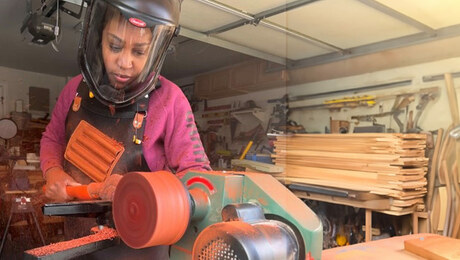As a wood turner, I cherish the process of turning raw wood into beautiful vessels on the lathe. However, the transformation process is just the beginning of my creative journey. Behind the lathe lies a world of endless possibilities for enhancing wood masterpieces with texture, color, and intricate design elements.

Texture is the language of touch that speaks to the spirit of woodworking. In addition to the smooth finish achieved on the lathe, I introduced texture and design through robust carving. Padauk wood, known for its vibrant color, is traditionally used for carving. It was the perfect choice for implementing modern-day technologies. Using a rotary tool and ball drill, I carefully carved shallow holes into this bowl, leaving a rounded finish in the upper quarter of the bowl.




Color is a powerful tool to arouse emotions and enhance aesthetic effect. While many wood species are naturally beautiful in their variety of grains and colours, staining, staining or painting can be used to enhance or change these characteristics. Dyes offer a more vibrant and transparent option, allowing the wood’s natural beauty to shine while delivering bold colors and hues. Experimenting with different techniques and color combinations allows wood experts to create pieces that match their artistic vision and personal style. There’s something about red and black joining this pair so nicely here. I brushed a polymer-based putty specifically for the substrates to bring out the power-sculpted effects.




The design is the culmination of craftsmanship and creativity, shaping the visual and functional aspects of the inverted bowl or plate. Before removing the tarara (also known as canarywood), I created a small channel to add contrast and visual interest against the yellow-colored Brazilian species. With the introduction of two-part pigmented epoxy and mica, this dish was transformed into a bright and cheerful rainbow.




In conclusion, the possibilities of improving turned bowls after the lathe are limited only by the imagination and creativity of the carpenter. By exploring texture, color and design, we can transform simple bowls into extraordinary works of art that delight the senses and inspire admiration, like this walnut bowl in which I added complementary inlay. Whether through carving, painting or innovative design, let us seize the opportunity to elevate our woodworking craft and create pieces that leave a lasting impression.



Add color and texture to an upside-down bowl
Mark Gardner demonstrates the steps involved in making one of his colorful bowls, from cutting a tree trunk, to initial stirring and drying, to the final finishing touches using milk paint and etching for installation.


Video: Decorative and carved cutting board
Mark Gardner adds texture and texture to edges by pulling the board across the bandsaw blade diagonally. This video shows exactly how this is done.


Use a rubbing plane to create a textured finish
Cleaning planes can do more than just hard work.
Sign up for emails today and get the latest techniques and tips from Fine Woodworking, plus special offers.

